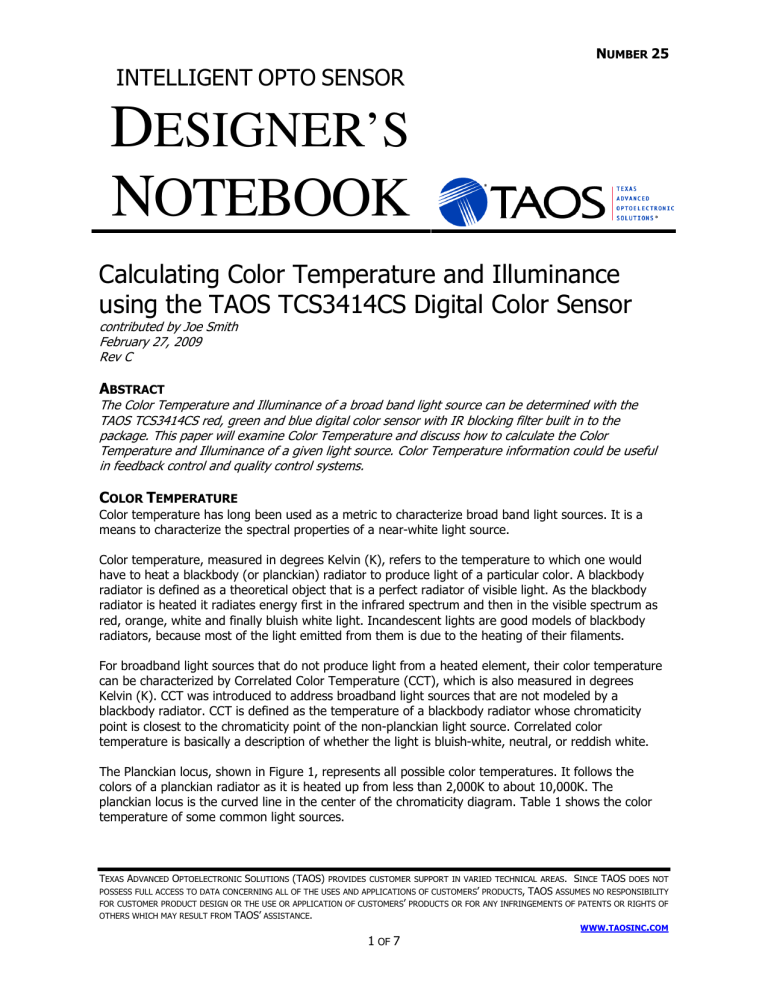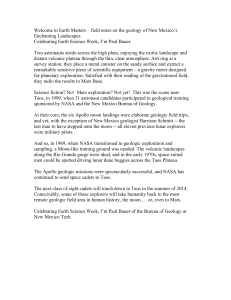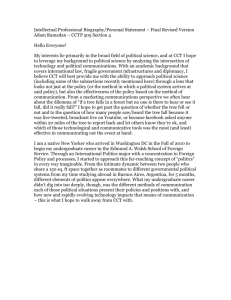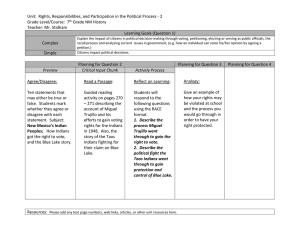Calculating Color Temperature and Illuminance

N UMBER 25
INTELLIGENT OPTO SENSOR
D
ESIGNER’S
N
OTEBOOK
Calculating Color Temperature and Illuminance using the TAOS TCS3414CS Digital Color Sensor
contributed by Joe Smith
February 27, 2009
Rev C
A BSTRACT
The Color Temperature and Illuminance of a broad band light source can be determined with the
TAOS TCS3414CS red, green and blue digital color sensor with IR blocking filter built in to the package. This paper will examine Color Temperature and discuss how to calculate the Color
Temperature and Illuminance of a given light source. Color Temperature information could be useful in feedback control and quality control systems.
C OLOR T EMPERATURE
Color temperature has long been used as a metric to characterize broad band light sources. It is a means to characterize the spectral properties of a near-white light source.
Color temperature, measured in degrees Kelvin (K), refers to the temperature to which one would have to heat a blackbody (or planckian) radiator to produce light of a particular color. A blackbody radiator is defined as a theoretical object that is a perfect radiator of visible light. As the blackbody radiator is heated it radiates energy first in the infrared spectrum and then in the visible spectrum as red, orange, white and finally bluish white light. Incandescent lights are good models of blackbody radiators, because most of the light emitted from them is due to the heating of their filaments.
For broadband light sources that do not produce light from a heated element, their color temperature can be characterized by Correlated Color Temperature (CCT), which is also measured in degrees
Kelvin (K). CCT was introduced to address broadband light sources that are not modeled by a blackbody radiator. CCT is defined as the temperature of a blackbody radiator whose chromaticity point is closest to the chromaticity point of the non-planckian light source. Correlated color temperature is basically a description of whether the light is bluish-white, neutral, or reddish white.
The Planckian locus, shown in Figure 1, represents all possible color temperatures. It follows the colors of a planckian radiator as it is heated up from less than 2,000K to about 10,000K. The planckian locus is the curved line in the center of the chromaticity diagram. Table 1 shows the color temperature of some common light sources.
T EXAS A DVANCED O PTOELECTRONIC S OLUTIONS (TAOS) PROVIDES CUSTOMER SUPPORT IN VARIED TECHNICAL AREAS .
S INCE TAOS DOES NOT
POSSESS FULL ACCESS TO DATA CONCERNING ALL OF THE USES AND APPLICATIONS OF CUSTOMERS ’ PRODUCTS , TAOS ASSUMES NO RESPONSIBILITY
FOR CUSTOMER PRODUCT DESIGN OR THE USE OR APPLICATION OF CUSTOMERS ’ PRODUCTS OR FOR ANY INFRINGEMENTS OF PATENTS OR RIGHTS OF
OTHERS WHICH MAY RESULT FROM TAOS’ ASSISTANCE .
WWW .
TAOSINC .
COM
1
OF
7
Calculating Color Temperature using the TAOS TCS3414CS Digital Color Sensor
Figure 1.
Chromaticity Diagram with Planckian Locus
Light Source
Candle flame
Sunlight at sunset
Tungsten bulb--60 watt
Tungsten bulb--200 watt
Tungsten/halogen lamp
Carbon arc lamp
Sunlight plus skylight
Color Temperature (K)
1900
2000
2800
2900
3300
3780
5500
Xenon strobe light
Overcast sky
6000
6500
North sky light 10000
Table 1.
Blackbody Radiator Temperature Approximation of Various Illuminants
T EXAS A DVANCED O PTOELECTRONIC S OLUTIONS (TAOS) PROVIDES CUSTOMER SUPPORT IN VARIED TECHNICAL AREAS .
S INCE TAOS DOES NOT
POSSESS FULL ACCESS TO DATA CONCERNING ALL OF THE USES AND APPLICATIONS OF CUSTOMERS ’ PRODUCTS , TAOS ASSUMES NO RESPONSIBILITY
FOR CUSTOMER PRODUCT DESIGN OR THE USE OR APPLICATION OF CUSTOMERS ’ PRODUCTS OR FOR ANY INFRINGEMENTS OF PATENTS OR RIGHTS OF
OTHERS WHICH MAY RESULT FROM TAOS’ ASSISTANCE .
WWW .
TAOSINC .
COM
2
OF
7
Calculating Color Temperature using the TAOS TCS3414CS Digital Color Sensor
I LLUMINANCE
Illuminance is defined as the Luminous flux incident on a surface per unit area, and can generally be described as the perceived brightness of visible light. The symbol for Illuminance is E v
and the SI unit is Lux, which is equal to one Lumen per square meter.
Illuminance is a good metric for determining ambient light. Ambient light information can be quite useful in many applications, especially display driven ones. Controlling display brightness based on ambient light measurements can improve the visual experience to the user, and improve power efficiency by not wasting power on maximum display brightness when it is not warranted by the ambient environment. For more information on ambient light sensing, please see “
TAOS DN26:
Ambient Light Sensing
”.
TCS3414CS
The TCS3414CS digital color sensor returns data from four channels: red(R), green(G), blue(B) and clear(C)(non-filtered). The response from the red, green and blue channels (RGB) can be used to determine a particular source’s CCT. The key to accomplishing this is to transfer the RGB responses to the chromaticity diagram in Figure 1 and find the point on the planckian locus closest to our source’s chromaticity point.
Chromaticity coordinates (x, y) are based on standard tristimulus values (XYZ). These standards are set by the Commission Internationale de l’Eclairage (CIE). The CIE is the main international organization concerned with color and color measurement.
In order to acquire a CCT for a given light source using a TCS3414CS, we must first map the sensor response (RGB) to the CIE tristimulus values (XYZ). It is then necessary to calculate the chromaticity coordinates (x, y) and finally the correlated color temperature (CCT). Figure 2 displays an overview of this process as well as the methods used for each transformation.
RGB xy
C ORRELATION M ATRIX
(3:3 T
RANSFORM
)
3:2
T
RANSFORM
M C C AMY ’ S F ORMULA
XYZ
CCT
Figure 2.
CCT calculation process overview
To obtain the illuminance, the first step is all that is necessary. The tristimulus Y value represents the illuminance of our source.
T EXAS A DVANCED O PTOELECTRONIC S OLUTIONS (TAOS) PROVIDES CUSTOMER SUPPORT IN VARIED TECHNICAL AREAS .
S INCE TAOS DOES NOT
POSSESS FULL ACCESS TO DATA CONCERNING ALL OF THE USES AND APPLICATIONS OF CUSTOMERS ’ PRODUCTS , TAOS ASSUMES NO RESPONSIBILITY
FOR CUSTOMER PRODUCT DESIGN OR THE USE OR APPLICATION OF CUSTOMERS ’ PRODUCTS OR FOR ANY INFRINGEMENTS OF PATENTS OR RIGHTS OF
OTHERS WHICH MAY RESULT FROM TAOS’ ASSISTANCE .
WWW .
TAOSINC .
COM
3
OF
7
Calculating Color Temperature using the TAOS TCS3414CS Digital Color Sensor
CCT AND I LLUMINATION C ALCULATION
Following the diagram in Figure 2, the first step is to map the RGB sensor response to the CIE tristimulus values, XYZ. This transform is necessary to account for any discrepancies between the spectral response of the sensor and that of the CIE tristimulus values. The two normalized responses are plotted next to each other in Figure 3.
Figure 3.
TCS3414CS RGB Normalized response vs. CIE tristimulus XYZ
Equations 1-3 can be used to correlate the RGB and XYZ values. These equations are the result of a transformation matrix composed of correlations at different light sources.
X = (-0.14282)(R) + (1.54924)(G) + (-0.95641)(B)
Y = (-0.32466)(R) + (1.57837)(G) + (-0.73191)(B) = Illuminance
Z = (-0.68202)(R) + (0.77073)(G) + (0.56332)(B)
Once the tristimulus values are determined, the chromaticity coordinates can be calculated. This
(1)
(2)
(3) process will allow the light to be plotted on a two-dimensional chromaticity diagram such as the one shown in figure 1. To this end, equations 4 and 5 can be used. x = X/(X+Y+Z) (4)
T EXAS A DVANCED O PTOELECTRONIC S OLUTIONS (TAOS) PROVIDES CUSTOMER SUPPORT IN VARIED TECHNICAL AREAS .
S INCE TAOS DOES NOT
POSSESS FULL ACCESS TO DATA CONCERNING ALL OF THE USES AND APPLICATIONS OF CUSTOMERS ’ PRODUCTS , TAOS ASSUMES NO RESPONSIBILITY
FOR CUSTOMER PRODUCT DESIGN OR THE USE OR APPLICATION OF CUSTOMERS ’ PRODUCTS OR FOR ANY INFRINGEMENTS OF PATENTS OR RIGHTS OF
OTHERS WHICH MAY RESULT FROM TAOS’ ASSISTANCE .
WWW .
TAOSINC .
COM
4
OF
7
Calculating Color Temperature using the TAOS TCS3414CS Digital Color Sensor y = Y/(X+Y+Z) (5)
Next, to determine the CCT from the chromaticity coordinates, McCamy’s formula (6) can be used.
McCamy claims that the formula can provide a maximum absolute error of less than 2 degrees Kelvin for color temperatures ranging from 2,856 to 6,500 K (corresponding to CIE illuminants A through
D65) given a particular x,y chromaticity coordinate.
CCT = 449n
3
+ 3525n
2
+ 6823.3n + 5520.33 where n = (x − 0.3320) / (0.1858 − y)
(6)
Note that the calculated CCT becomes less meaningful as the source moves further away from the planckian locus. For instance, it would be possible to generate a CCT for a green LED, but the value would be meaningless as the point on the chromaticity diagram would be too far from the planckian locus. In other words, the CCT is only meant to characterize near white lights.
Equations 1-6 can be combined to form equation 7 below.
CCT = 449n
3
+ 3525n
2
+ 6823.3n + 5520.33 (7) where n = ((0.23881)R+(0.25499)G+(-0.58291)B) / ((0.11109)R+(-0.85406)G+(0.52289)B)
CCT AND I LLUMINANCE C ALCULATION E XAMPLE
The following example will detail the process for obtaining the CCT for a 3000K Sylvania E114 fluorescent bulb. The starting point for this calculation will be the obtained RGB values from the
TCS3414CS. In this example, those values are R=231, G=260, B=95. Next these RGB values are mapped to their XYZ counterparts using equations 1, 2 and 3.
X = (-0.14282)(231) + (1.54924)(260) + (-0.95641)(95) = 279.0
Y = (-0.32466)(231) + (1.57837)(260) + (-0.73191)(95) = 265.8
Z = (-0.68202)(231) + (0.77073)(260) + (0.56332)(95) = 96.4
Illuminance = (-0.32466)(231)+(1.57837)(260)+(-0.73191)(95) = 265.8 Lux
To determine the CCT, chromaticity coordinates must be calculated using equations 4 and 5. x = (279.0)/(279.0+265.8+96.4) = 0.4351 y = (265.8)/(279.0+265.8+96.4) = 0.4146
Using McCamy’s formula (eq. 6) the CCT can be determined as follows. n = (0.4351 − 0.3320) / (0.1858 – 0.4146) = -0.4504
CCT = (449)(-0.4504)
3
+(3525)(-0.4504)
2
+(6823.3)(-0.4504)+5520.33 = 3121 K
T EXAS A DVANCED O PTOELECTRONIC S OLUTIONS (TAOS) PROVIDES CUSTOMER SUPPORT IN VARIED TECHNICAL AREAS .
S INCE TAOS DOES NOT
POSSESS FULL ACCESS TO DATA CONCERNING ALL OF THE USES AND APPLICATIONS OF CUSTOMERS ’ PRODUCTS , TAOS ASSUMES NO RESPONSIBILITY
FOR CUSTOMER PRODUCT DESIGN OR THE USE OR APPLICATION OF CUSTOMERS ’ PRODUCTS OR FOR ANY INFRINGEMENTS OF PATENTS OR RIGHTS OF
OTHERS WHICH MAY RESULT FROM TAOS’ ASSISTANCE .
WWW .
TAOSINC .
COM
5
OF
7
Calculating Color Temperature using the TAOS TCS3414CS Digital Color Sensor
C ORRELATION M ATRIX
In the previous example, equations 1, 2 and 3 were used to map the TCS3414CS RGB responses to their CIE tristimulus equivalents. These equations are the equation form of a 3x3 transformation matrix that was determined through empirical data on three distinguishable light sources. To achieve a broad enough transformation, the light sources chosen were a high color temperature fluorescent
(6500K), a low color temperature fluorescent (3000K), and an incandescent (60W).
In certain applications it may be desirable to acquire more precision in calculating the CCT across a narrower range of light sources. In such a case, a new correlation matrix could be formulated. To accomplish this, it is recommended that a high quality color meter be used to establish the CIE tristimulus values for the control light source. Once the XYZ and RGB values are obtained for three light sources a transformation matrix can be formulated.
Care should be taken in choosing the three sources to use for the correlation matrix. One choice would include the limits of the target range, along with one source near the middle of the range. For instance, if fluorescent lights were the only concern, good control light sources might be a 3000K bulb, a 6500K bulb and a 4500K bulb.
The following shows how the correlation matrix was formed that resulted in equations 1, 2 and 3. The correlation matrix ( C ) can be obtained by multiplying the tristimulus matrix ( T ) to the inverse of the sensor response matrix ( S ) as shown in equation 8.
C = T • S
-1
(8)
C =
C =
X
60W
Y
60W
Z
60W
26.9
22.9
4.9
X
3000
Y
3000
Z
3000
274.7
262.2
96.5
X
6500
Y
6500
Z
6500
321.8
R
60W
• G
60W
B
60W
67.5
360.5 • 43.0
335.5 31.5
R
3000
G
3000
B
3000
R
G
B
6500
6500
6500
226.5 226.5
256.5 415.0
94.5 302.0
-1
-1
C =
26.9
22.9
4.9
274.7
262.2
96.5
321.8 0.02261 -0.02779 0.02122
360.5 • 0.00005 0.00783 -0.01080
335.5 -0.00237 0.00045 0.00448
-0.14282
C = -0.32466
-0.68202
1.54924 -0.95641
1.57837 -0.73191
0.77073 0.56332
T EXAS A DVANCED O PTOELECTRONIC S OLUTIONS (TAOS) PROVIDES CUSTOMER SUPPORT IN VARIED TECHNICAL AREAS .
S INCE TAOS DOES NOT
POSSESS FULL ACCESS TO DATA CONCERNING ALL OF THE USES AND APPLICATIONS OF CUSTOMERS ’ PRODUCTS , TAOS ASSUMES NO RESPONSIBILITY
FOR CUSTOMER PRODUCT DESIGN OR THE USE OR APPLICATION OF CUSTOMERS ’ PRODUCTS OR FOR ANY INFRINGEMENTS OF PATENTS OR RIGHTS OF
OTHERS WHICH MAY RESULT FROM TAOS’ ASSISTANCE .
WWW .
TAOSINC .
COM
6
OF
7
Calculating Color Temperature using the TAOS TCS3414CS Digital Color Sensor
Once C is determined it can be used to transform the sensor response to a set of equivalent tristimulus values in the following manner.
T = C • S
X -0.14282 1.54924 -0.95641 R
Y = -0.32466 1.57837 -0.73191 • G
Z -0.68202 0.77073 0.56332 B
This is equivalent to equations 1, 2 and 3.
C ONCLUSION
The classification of near-white light through Correlated Color Temperature and Illuminance can be accomplished by utilizing the RGB color responses of the TCS3414CS to a particular source. Utilizing several calculations, the CCT and Illuminance for any near-white light source can be determined.
R EFERENCES
Malacara, Daniel, Color Vision and Colorimetry Theory and Applications, SPIE Press, Bellingham WA,
2002
McCamy, C. S. 1992. Correlated Color Temperature as an Explicit Function of Chromaticity
Coordinates, Color Research & Application 17:142–144
T EXAS A DVANCED O PTOELECTRONIC S OLUTIONS (TAOS) PROVIDES CUSTOMER SUPPORT IN VARIED TECHNICAL AREAS .
S INCE TAOS DOES NOT
POSSESS FULL ACCESS TO DATA CONCERNING ALL OF THE USES AND APPLICATIONS OF CUSTOMERS ’ PRODUCTS , TAOS ASSUMES NO RESPONSIBILITY
FOR CUSTOMER PRODUCT DESIGN OR THE USE OR APPLICATION OF CUSTOMERS ’ PRODUCTS OR FOR ANY INFRINGEMENTS OF PATENTS OR RIGHTS OF
OTHERS WHICH MAY RESULT FROM TAOS’ ASSISTANCE .
WWW .
TAOSINC .
COM
7
OF
7




